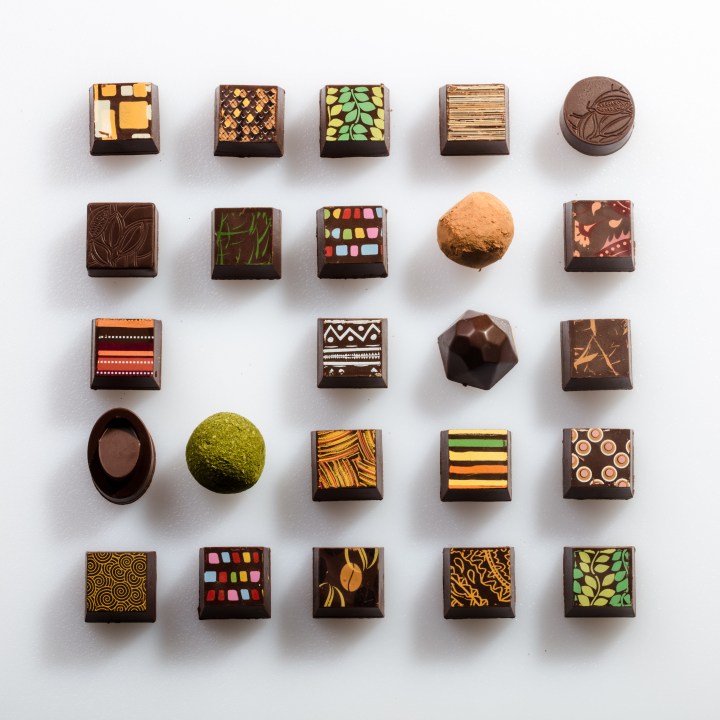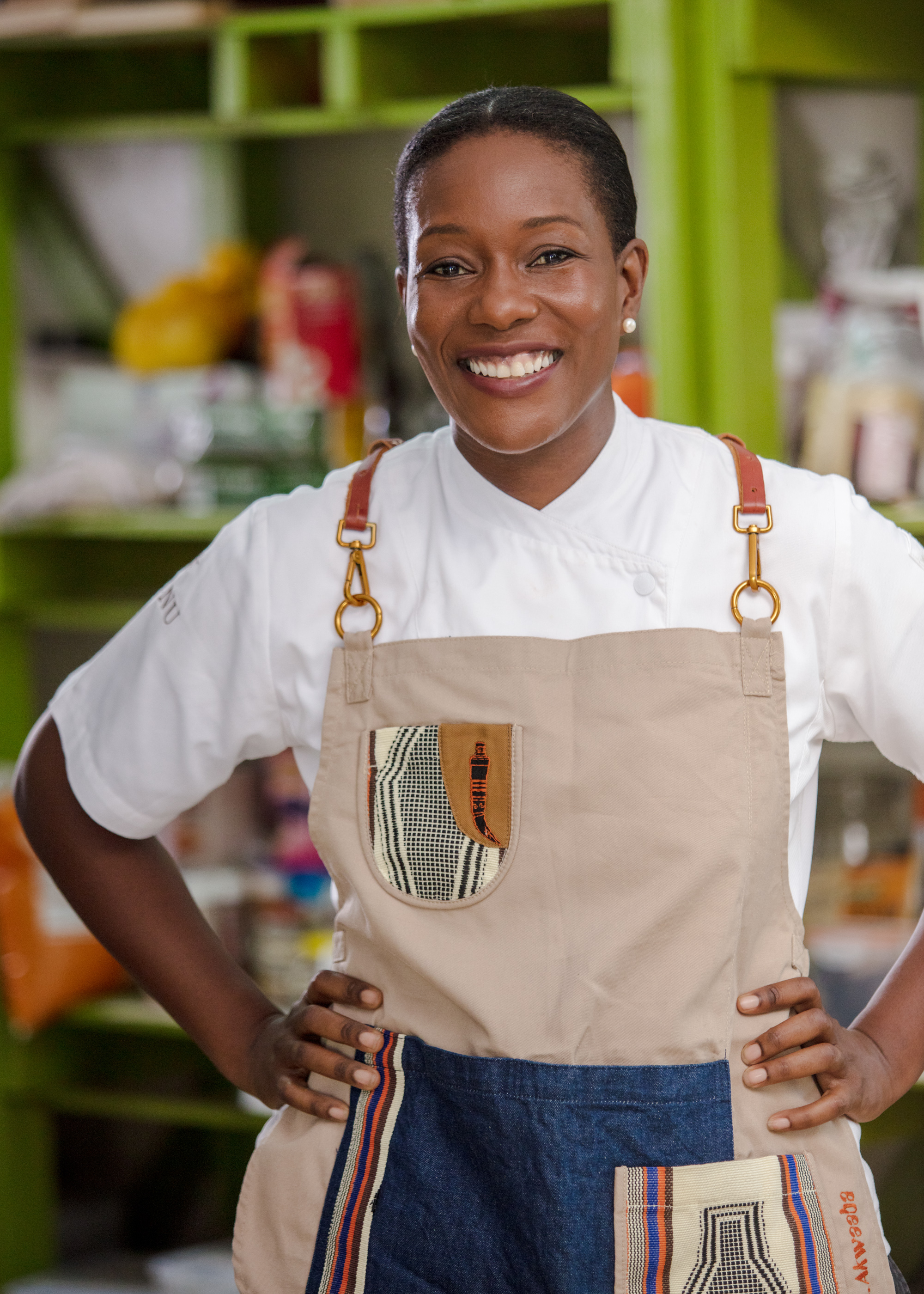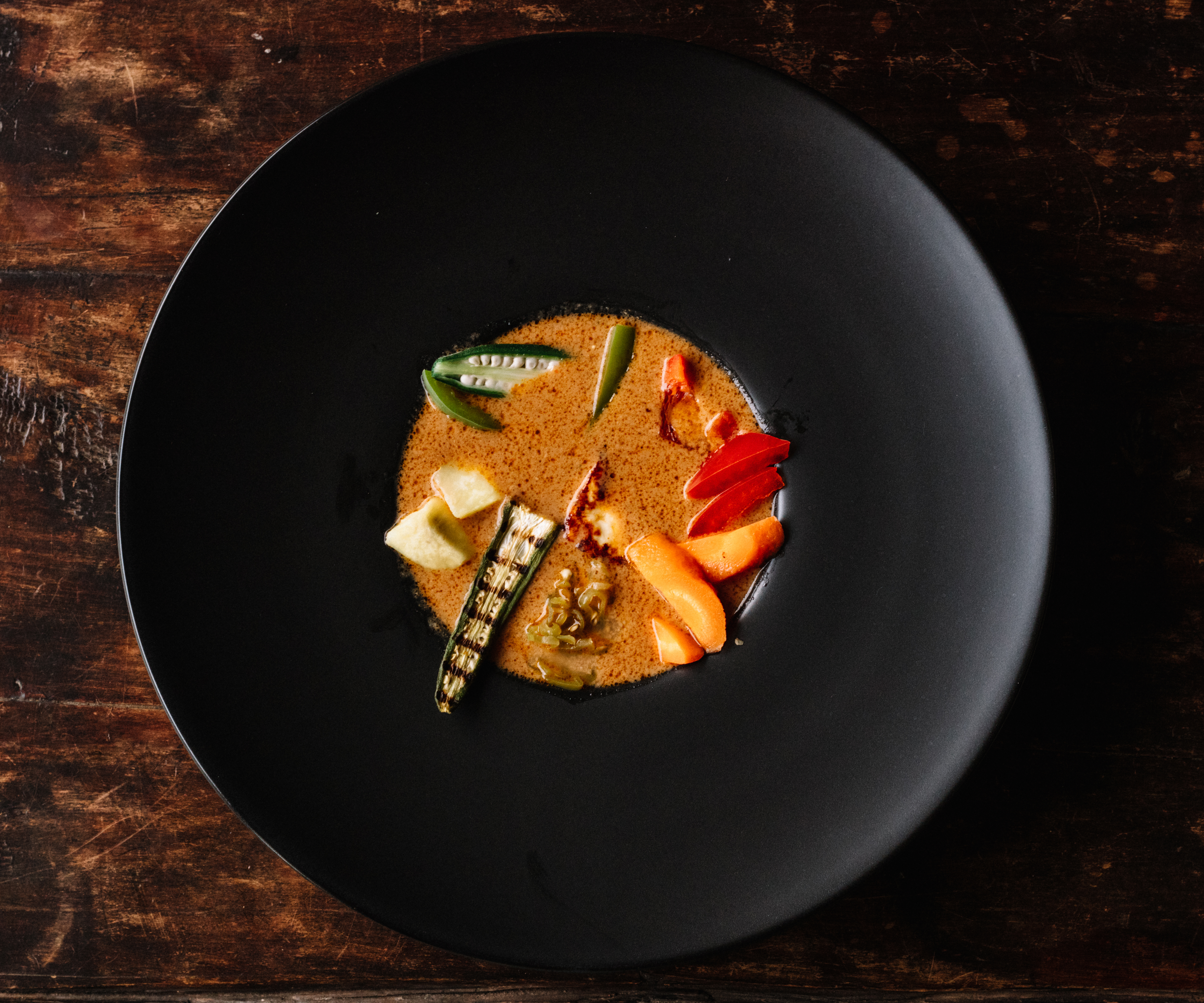SELASSIE ATADIKA
The Ghanaian chef taking Africa’s bold flavours to the world

A Ghanaian-born chef wants to be a food influencer for Africa, in the best sense of the word. Her polished plates serve plant-forward food created from little-known pods, nuts and grains.
Selassie Atadika is on a quest to change diners’ perceptions of Africa’s food. The humanitarian-turned-chef with an American accent regularly travels the continent and also spreads her message in key international destinations.
Accra-based Atadika was born in Ghana but grew up in the US. Labelling herself a “culinary nomad”, she started developing an extensive, personal African-food flavour database when work travel took her through Africa and Eastern Europe.
“I studied geography. And then I joined the UN. My work was mostly with UNICEF, working with women and children around the African continent. I travelled a lot and ate a lot. I was in the Central African Republic when I fell in love with maboké. I usually prefer the fish one, grilled inside a banana leaf.
“In Ethiopia I fell in love with injera, a sourish flatbread. In Kenya I loved the Swahili cuisine. I ate a type of meat in Sudan that tasted so familiar to me – what I was eating was from Ghana. And being from Ghana, my favourite dish is anything to do with plantain, so I love a dish called kelewele,” she continued. It’s a spicy fried snack of cubed or sliced ripe plantain, spiced with ginger and pepper.
A nostalgic food experience in South Sudan led to a career change – Atadika signed up for a cheffing course at the Culinary Institute of America.
Midunu – come, let’s eat

Selassie Atadika. Photo: Midunu
Since 2014, Atadika has made Ghana home and the site of her restaurant, Midunu. It roughly translates as “come, let’s eat”. Once a week, diners can partake in a food and cultural private dining experience, in a tasting menu format labelled “new African cuisine”. There’s a focus on communal swapping of dishes among willing participants. Atadika calls it a nomadic experience because the restaurant often moved location in Accra when it started. It’s also a fit with her own nomadic lifestyle.
“There is not a lot of knowledge of food coming from East and West Africa,” said Atadika. “I started understanding more about food waves: the cultural practices and traditions that come into place. In Ghana, Tuesday is a taboo day for fishing, for instance. It’s one of the practices that has helped us maintain sustainability for many decades.”
Touching on festival foods, she explained how some yam festivals in West Africa coincide with malaria season because it’s believed that chemicals in yams protect from malaria infection. “I started looking at preservation techniques. In Africa today, a lot of these are not only preservation but ways of flavouring foods via salting and smoking techniques.”
Presenting at Design Indaba festival, she offered Cape Town audiences a tasting box labelled: sweet, salty, bitter, sour and umami.
For sweet, there was fibrous sugar cane, which Ghanaians used to suck on as children. It’s a palate cleanser now at her Midunu restaurant. A raw dune spinach leaf represented the salty element (this one, from the Cape’s West Coast). For bitter, dark kola nuts were certainly that. They’re chewed in many West African countries. For umami: dark, salty dawadawa, made by fermenting African locust bean legumes. Atadika called dawadawa her “vegan version of Asian fish sauce”.
We were also introduced to a spice representing heat. Reddish-ochre in colour, berebere is a smoky medium-heat chilli blend from Ethiopia. It reminded me of Spanish smoked paprika. A mix of red chilli, black pepper, ginger, cloves and more, it’s often used in African chicken dishes or meat stews.
To a South African palate, many of the West and East African ingredients in their raw form tasted unfamiliar, even peculiar. “I thought some of it was downright awful,” remarked a foodie friend.
On Midunu’s website, the Herbivore or Omnivore menu descriptions weren’t much help. The Ominivore menu begins with this list: amaranth, apple, bambara groundnuts, cassava, chicken, cocoa, coconut, cocoyam, cowpeas, dika seed, ginger, goat, groundnuts …
Spreading the gospel
Chatting to Atadika later, I told her I felt interested but unconnected to foods at the top end of this continent we share. Her reply: West and East African dishes and ingredients are not widely known. It’s why, as an international chef, she’s encouraging less reliance on imported products in local communities, to improve health and boost Africa’s economies.
“A lot of African cuisines are plant-forward because eating meat is a luxury. Plants, nuts, beans and legumes provide a protein source. If you say something is plant-forward in Ghana, it’s not always attractive. So I use those elements to put together my plate for diners at Midunu.”

Atadika’s green ravioli fine dining plate has a filling of seeds. It’s served with cashew cream. Photo: Midunu
“I had a juice in Ethiopia with avocado and papaya. I decided to turn it into a Midunu dessert. They use a lot of honey and cardamom in their cuisine. I popped sorghum with it because so many grains are used there.
“In French classic cuisine, you see a lot of butter and cream. In African cuisine, you see a lot of bold flavours instead of those fattier things,” she explained of the differences.

Midunu’s roasted plantain dish with roasted groundnuts has tiger nut milk replacing cream. Similarly, the creamy texture in her groundnut soup is created naturally from grinding nuts into a paste. Photo: Midunu
Atadika is also introducing local herb equivalents for fresh parsley and coriander leaves. Initially she had an uphill battle when plants she found were rejected out of hand because they had medicinal or cultural uses.
“Now I say to my local colleagues: give me the names of all the medicines,” she chuckled. “I’ve already used scent leaf, a wild basil that grows very well in Ghana. I’m making these local herbs find their way onto my menu.”
Food influencer
A current frustration is Ghanaian food perceptions where anything from somewhere else seems to hold much more sway. “One of the reasons I decided to be a chef: I wanted to be an influencer and bring people on board. I like to use a lot of millet and sorghum,” said Atadika. “In Ghana those things are totally out of style.”
She showed off a bag containing a pale grain that looked like a finer version of raw quinoa. “Take fonio, a hugely popular grain internationally from West Africa that is drought-tolerant. It’s kind of like the next quinoa.
“Fonio is considered poor people’s food. It’s grown in two districts in Ghana and would be easy to export. But in Ghana, it’s very hard to find fonio; only quinoa is found on fine dining menus. In New York, I can order on amazon and have fonio delivered the next day.”
The humanitarian warmed to her theme. “I’ve learnt from my time in Ghana, we’re late adopters. You need to know that other people think it’s cool and hip. So I use fonio on my menu and I’m trying to get other chefs in Ghana to use it too. We need to get to a place where we’re making cereals and granola bars out of fonio, rather than just sending the raw ingredients to other countries, creating jobs locally at the same time.”
Drawing on her UN background, Atadika explained that Africa’s annual food import bill of $35-billion is estimated to reach $110-billion by 2025. A lot of ancient African grains grow in drought-stricken areas. Her data shows that only 16 to 18% of contents of local grocery stores originate in Ghana. “If you look at the economy, food is directly linked to this issue. In terms of health and nutrition, what makes better sense for us to eat in Africa? Is it really about corn and rice in agriculture, or are there other crops we should be using?”
Perceptions and aesthetics

Roasted groundnut soup relies on ground nuts for creaminess, not cream. Photo: Midunu
Appearances at international festivals allow this chef opportunities to change negative perceptions. So does her Accra restaurant. “There was this notion that African food is not attractive. So I thought I’m going to change that with aesthetics, then bring more people in. When I design a Midunu plate, first I think about its content and history/economic and cultural impact/personal nutrition. Then it needs to be delicious. Then to be beautiful. But in Ghana, the visual is what strikes many diners first.”
Midunu’s set menus are pricey, so it is generally expats who make reservations. Guests also include Ghanaians who’ve lived abroad, who want their kids to see their food in a new light.
“The trend is now that other people are coming and seeing that I have international recognition. But in Ghana there is a lack of understanding of how to write about food and restaurants,” shrugged Atadika. “When I won some international food awards last year, the local media didn’t find it relevant. Food is viewed as a necessity rather than as an art.”
She conceded that Accra restaurants have developed a greater level of professionalism in the past 10 years. But not many make it because it’s such a big investment: securing a location in Accra means paying two years of rent upfront. Luckily for Atadika, her restaurant is in their old family house in a spacious compound, modified to include a commercial kitchen. Very few higher-end restaurants offer Ghanaian dining either – growth has been in French, Italian and Japanese food first.
I observed a similar international dining focus in Singapore when I reviewed upmarket restaurants while working on a food and wine magazine there 20 years ago. Coveting and copying foreign restaurants seemed misplaced in this small Asian country so obsessed with eating. But it’s also a natural progression, until your cheffing community becomes sufficiently confident of the value of its local specialities to look inwards for direction.
Good feedback
Atadika hosted a Midunu dinner pop-up at Cape Town’s Aubergine Restaurant during Design Indaba. I asked chef-owner Harald Bresselschmidt how it was received. “We had a lot of regulars coming plus a few visitors. We had good feedback,” he said. The classically trained chef helped Atadika prep for the dinner.
The most talked-about dish was WreWre soup, finished with dawadawa. It was served with roasted ceps. “On its own, the WreWre soup was sort of nutty in flavour,” said Bresselschmidt. “Wild melon seeds, slow-cooked with lots of onion, tomato and spices to create smokiness, all blended to a creamy soup texture. “People said they had nothing in their frame of reference when eating it. The ingredients were very different, the dawadawa beans fermented.
“They loved the chicken liver mousse with groundnuts and her special dark chocolate, served as a snack at the start. It had a honey brittle,” he added. Atadika’s menu also included a fonio and dune spinach salad. An oxtail dish had a sauce reliant on richly buttery aromatics from dried prekese pods, grown in Ghana.
“In general, the flavours weren’t something I was familiar with. She purees a lot, cooks a lot of vegetarian food. But the way her food was in balance was amazing,” said Bresselschmidt. “Personally I thought the meal was delicious. She uses a lot of spice, so it’s quite potent. A dish often has six or seven components, and those were all harmonising.” Atadika’s meals all end with beautiful dark chocolate bonbons. These handcrafted artisanal chocolates are made with Ghanaian cocoa.
So, as South Africans with limited access to ingredients and flavours north of our borders, what is the takeaway? It’s that Atadika is finding, and then promoting, a food identity for Ghana and some lesser-known neighbours. As she put it: “There is so much in Africa. It’s about opening people’s eyes and being curious about what we have.
“The spice in the dark chocolates I serve at the end of the meal doesn’t even have an English name. We’re adding to the food vocabulary. And even within the continent, the language is large.” DM





 Become an Insider
Become an Insider